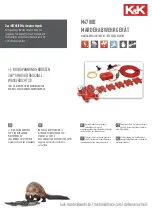
Fuel can be trimmed by + or – 15%.
B.11. Using the Ignition Advance Trims
Just as the fuel injector trims allow the fuel to be fine-tuned between cylinders, the Ignition
Advance Trim feature allows timing to be adjusted based on coil output channels. When in phase-
sequential operation, the coils can be trimmed in waste-spark pairs. When in full-sequential operation, the
coils can be trimmed on an individual cylinder basis.
When the Ignition Advance trim is used, a set amount of timing can be added to or subtracted from
the Ignition Advance curve. Certain engines have the tendency to detonate on certain cylinders more than
others. To counteract this issue, the Ignition Advance Trim can be used to remove timing from the
problematic cylinders.
Timing can be adjusted by + or – 15
o
.
B.12. Tuning the EGO Sensor
Tuning the EGO sensor is the final step in the engine tuning process. Since EGO sensors are only
designed to provide a switch-point for stoichiometric operation, it is not recommended that the EGO be
used in closed loop mode for anything other than its intended design: part throttle and idling stoichiometric
control.
Start with tuning the EGO in closed-loop at idle. (Keep in mind that some exhaust configurations
may not generate enough heat at idle to keep the sensor warm enough for repeatable readings.) With the
engine running at the desired idle speed, lean the mixture out enough to detect a slight lean misfire. This
can be done by manipulating the IOT/POT or the Volumetric Efficiency Table. The EGO reading will
typically begin to sway back and forth erratically when misfiring is occurring. Richen the engine back up
in small increments (1% VE adjustments, or 0.01 ms POT adjustments) until the misfiring is less
noticeable. At this point, the EGO reading should come back in line. Record the EGO reading at this time,
and enter this value into the Air Fuel Ratio Table at cells surrounding (and including) the idle MAP/RPM
point. Keep in mind that if the EGO is detecting an AFR around the stoichiometric point, the reading will
be bouncing around slightly, but not nearly as erratically as when the engine is misfiring. If the EGO
reading is still bouncing around, and richening up the mixture does not fix the problem, the EGO is too cold
for closed-loop operation at idle.
When the idle is tuned in this manner, the engine will normally be running at its cleanest overall
emissions. This will reflect a balance between HC, CO, and NO
x
production, and will keep the catalytic
converter (if equipped) functioning properly. If an engine is running richer than stoichiometric, the NO
x
levels will fall, but the CO and HC levels will rise. Catalytic converters will become clogged with carbon
deposits when this happens, and the exhaust gas temperatures will fall. When an engine is running leaner
than stoichiometric, HC and CO levels will fall, but NO
x
levels will rise. Exhaust gas temperatures will
rise, and catalytic converters will not be able to eliminate the high levels of NO
x
.
On a gas analyzer, high NO
x
production is indicative of an overly-lean mixture. High HC and CO
levels are indicative of an overly-rich mixture. However, high HC levels with comparatively low CO
levels will occur when the engine is misfiring. As such, high HC can sometimes be thought of as a misfire
detector.
To use the EGO sensor at part-throttle, follow the same tuning procedure as was discussed for
tuning the idle. Target the part-throttle cruise RPM and MAP points in the VE Table, and tune them to
achieve an AFR of around 14.64. Once this is done, turn on the EGO sensor, and use the Desired Air Fuel
Ratio Table to fine-tune your EGO correction value.
When using the EGO sensor, a
15% Authority Range
should be the maximum necessary for a
properly tuned engine. An engine that requires more correction than 15% (in either direction) is not tuned
properly to begin with.
______________________________________________________________________________________
TECgt Manual Version 2.0
- Page 35 -
©2008 Electromotive, Inc.
















































